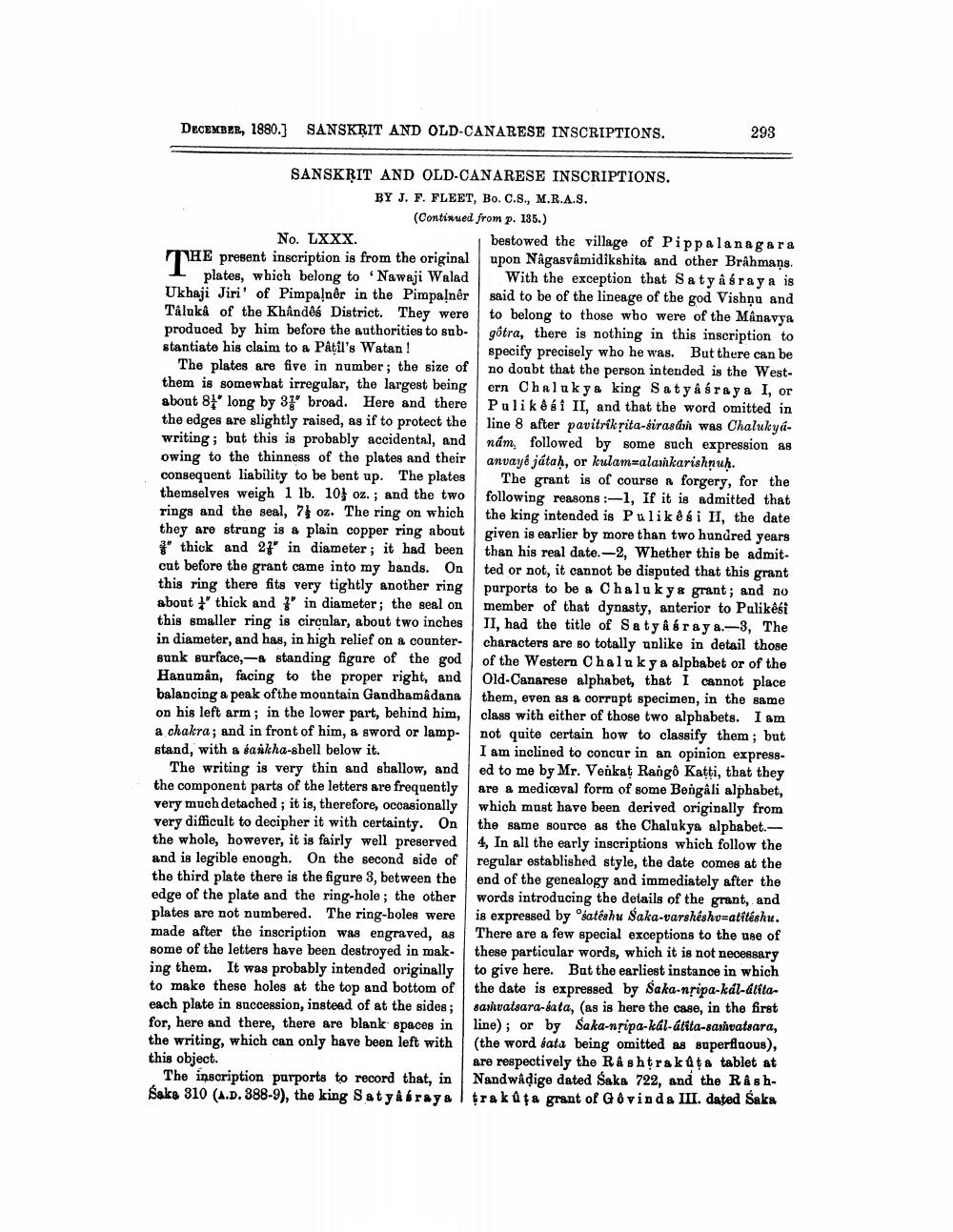________________
DECEMBER, 1880.] SANSKRIT AND OLD-CANARESE INSCRIPTIONS.
SANSKRIT AND OLD-CANARESE INSCRIPTIONS. BY J. F. FLEET, Bo. C.S., M.R.A.S. (Continued from p. 135.)
No. LXXX.
THE HE present inscription is from the original plates, which belong to Nawaji Walad Ukhaji Jiri' of Pimpalnêr in the Pimpalnêr Taluka of the Khândês District. They were produced by him before the authorities to substantiate his claim to a Pâtil's Watan!
The plates are five in number; the size of them is somewhat irregular, the largest being about 8 long by 33" broad. Here and there the edges are slightly raised, as if to protect the writing; but this is probably accidental, and owing to the thinness of the plates and their consequent liability to be bent up. The plates themselves weigh 1 lb. 10 oz. ; and the two rings and the seal, 7 oz. The ring on which they are strung is a plain copper ring about
thick and 27" in diameter; it had been cut before the grant came into my hands. On this ring there fits very tightly another ring about" thick and 3" in diameter; the seal on this smaller ring is circular, about two inches in diameter, and has, in high relief on a countersunk surface, a standing figure of the god Hanuman, facing to the proper right, and balancing a peak of the mountain Gandhamâdana on his left arm; in the lower part, behind him, a chakra; and in front of him, a sword or lampstand, with a sankha-shell below it.
The writing is very thin and shallow, and the component parts of the letters are frequently very much detached; it is, therefore, occasionally very difficult to decipher it with certainty. On the whole, however, it is fairly well preserved and is legible enough. On the second side of the third plate there is the figure 3, between the edge of the plate and the ring-hole; the other plates are not numbered. The ring-holes were made after the inscription was engraved, as some of the letters have been destroyed in making them. It was probably intended originally to make these holes at the top and bottom of each plate in succession, instead of at the sides; for, here and there, there are blank spaces in the writing, which can only have been left with this object.
The inscription purports to record that, in Saka 310 (A.D. 388-9), the king Satyaáraya
293
bestowed the village of Pippalanagara upon Nâgasvâmidikshita and other Brâhmans. With the exception that Saty à raya is said to be of the lineage of the god Vishnu and to belong to those who were of the Mânavya gôtra, there is nothing in this inscription to specify precisely who he was. But there can be no doubt that the person intended is the Western Chalukya king Satyasraya I, or Pulikêéi II, and that the word omitted in line 8 after pavitrikṛita-sirasdi was Chalukyanám, followed by some such expression as anvayê játaḥ, or kulam-alamkarishnuḥ.
The grant is of course a forgery, for the following reasons:-1, If it is admitted that the king intended is Pulikêsi II, the date given is earlier by more than two hundred years than his real date.-2, Whether this be admitted or not, it cannot be disputed that this grant purports to be a Chalukya grant; and no member of that dynasty, anterior to Pulikêsi II, had the title of Satyasraya.-3, The characters are so totally unlike in detail those of the Western Chalukya alphabet or of the Old-Canarese alphabet, that I cannot place them, even as a corrupt specimen, in the same class with either of those two alphabets. I am not quite certain how to classify them; but I am inclined to concur in an opinion expressed to me by Mr. Venkat Rangô Kaṭṭi, that they are a mediceval form of some Bengâli alphabet, which must have been derived originally from the same source as the Chalukya alphabet.-4, In all the early inscriptions which follow the regular established style, the date comes at the end of the genealogy and immediately after the words introducing the details of the grant, and is expressed by satéshu Saka-varsheshv-atítéshu. There are a few special exceptions to the use of these particular words, which it is not necessary to give here. But the earliest instance in which the date is expressed by Saka-nṛipa-kál-átítasamvatsara-sata, (as is here the case, in the first line); or by Saka-nṛipa-kál-átita-samvatsara, (the word sata being omitted as superfluous), are respectively the Rashtrakuta tablet at Nandwâdige dated Saka 722, and the Râshtrakuta grant of Govinda III. dated Śaka




